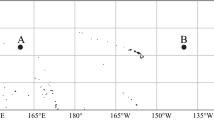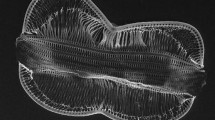Abstract
In order to determine the relative importance of autotrophic and heterotrophic activities in both bacterial and phytoplanktonic communities in an oligomesotrophic lake, the size fractionation by differential filtration and the use of a bacterial inhibitor (gentamycin) were combined. The study was carried out at Lake Pavin during the spring planktonic bloom. Photosynthetic and photo- and chemoheterotrophic activities were measured from the assimilation of NaH14CO3 and glucose-3H, using a double labeling technique. The bacterial community was at low cell concentration (0.6 to 7 × 105 cells ml−) and represented very low biomass values (0.9 to 11.5 μgC liter−1). The abundance of the phytoplankton varied between 0.5 and 1.8 × 106 cells liter−1, and biomass values ranged between 19 and 118 μgC liter−1. The diatom Melosira italica sp. subarctica (O. Mueller) was the largely dominant species in the meta- and hypolimnion. Inorganic fixation by photolithotrophy (mean value: 1.66 mg C m−3 hour−1) largely predominates over assimilation by photoheterotrophy (mean value: 0.93 μg C m−3 hour−1) or chemoheterotrophy (mean value: 2.42 μg C m−3 hour−1). However, because of the considerable underestimation of heterotrophic assimilation due to the experimental methods used, and because of the spatial and temporal separation of photolithotrophic and photo- and chemoheterotrophic activities, it is likely that the fixation of organic carbon by microalgae plays an important role in the survival of species and/or in competitive interactions, as the results with Monoraphidium contortum (Pasch. et Korschik.), the prevailing species in the epilimnion, would suggest.
Similar content being viewed by others
References
Amblard C (1988) Seasonal succession and strategies of phytoplankton development in two lakes of different trophic states. J Plankton Res 10:1189–1208
Amblard C, Bourdier G (1990) The spring bloom of the diatom Melosira italica subsp. subarctica in lake Pavin: Biochemical, energetic and metabolic aspects during sedimentation. J Plankton Res 12:645–660
Azam F, Holm-Hansen O (1973) Use of tritiated substrates in the study of heterotrophy in sea water. Mar Biol 23:191–196
Bailey-Watts AE (1986) Seasonal variations in size spectra of phytoplankton assemblages in Loch Leven, Scotland. Hydrobiologia 138:25–42
Bird DF, Kalff J (1986) Bacterial grazing by planktonic lake algae. Science 231:493–495
Bollman RC, Robinson GG (1985) Heterotrophic potential of the green alga, Ankistrodesmus braunii (Naeg). Can J Microbiol 31:549–554
Bourdier G, Bohatier J, Feuillade M, Feuillade J (1989) Amino acid incorporation by a natural population of Oscillatoria rubescens. A microautoradiographic study. Ferns Microbiol Ecol 62:185–190
Bratbak G (1985) Bacterial biovolume and biomass estimations. Appl Environ Microbiol 49:1488–1493
Dietz AS, Albright LJ, Tuominen T (1977) Alternative model and approach for determining microbial heterotrophic activities in aquatic systems. Appl Environ Microbiol 33:817–823
Droop MR (1974) Heterotrophy of carbon. In: Stewart WDP (ed) Algal physiology and biochemistry. Blackwell Scientific Publications, Oxford, pp. 530–559
Ellis BK, Stanford JA (1982) Comparative photoheterotrophy, chemoheterotrophy and photolithotrophy in a eutrophic reservoir and a oligotrophic lake. Limnol Oceanogr 27:440–454
Feuillade M, Feuillade J (1989) Heterotrophic capabilities of the blue-green algae Oscillatoria rubescens. Arch Hydrobiol 117:61–76
Haffner GD, Yallop ML, Hebert PDN (1988) Heterotrophic glucose assimilation in Lake Ontario. J Great Lakes Res 14:157–163
Hellebust JA (1970) The uptake and utilization of organic substances by marine phytoplankters. In: Hood DW (ed) Symposium on organic matter in natural waters. Inst Mar Sci Occas Publ no. 1 University of Alaska, Fairbanks, pp 223–256
Hellebust JA, Lewin J (1977) Heterotrophic nutrition. In: Werner D (ed) The biology of diatoms. Blackwell Scientific Publications, Oxford, pp 160–197
Hobbie JE, Daley RI, Jasper S (1977) Use of nucleopore filters for counting bacteria by fluorescence microscopy. Appl Environ Microbiol 33:1225–1228
Iturriaga R, Zsolnay A (1981) Differentiation between auto- and heterotrophic activity: Problems in the use of size fractionation and antibiotics. Bot Mar XXIV:399–404
Karlander EP, Krauss RW (1966) Responses of heterotrophic cultures of Chlorella vulgaris Beyerrinck to darkness and light. I. Pigment and pH changes. Plant Physiol 41:1–6
Legendre L, Demers S, Yentsch CM, Yentsch CS (1983) The 14C method: Patterns of dark CO2 fixation and DCMU correction to replace the dark bottle. Limnol Oceanogr 28:996–1003
Legendre L, Watt WD (1971–1972) On rapid technique for plankton enumeration. Ann Inst Oceanogr Paris XLVIII:173–177
Lewin JC, Hellebust JA (1976) Heterotrophic nutrition of the marine pennate diatom Nitzschia angularis var. affinis. Mar Biol 36:313–320
McKinley KR (1977) Light-mediated uptake of 3H-glucose in a small hardwater lake. Ecology 58:1356–1365
McKinley KR, Wetzel RG (1979) Pbotolithotrophy, photoheterotrophy and chemoheterotrophy: Patterns of resource utilization on an annual and a diurnal basis within a pelagic microbial community. Microbial Ecol 5:1–15
Moll R (1984) Heterotrophy by phytoplankton and bacteria in Lake Michigan. Verh Intern Verein Limnol 22:431–434
Munro ALS, Brock TD (1968) Distribution between bacterial and algal utilization of soluble substances in the sea. J Gen Microbiol 51:35–42
Neilson AH, Lewin RA (1974) The uptake and utilization of organic carbon by algae: an assay in comparative biochemistry. Phycologia 13:227–264
Ohki K, Katch T (1975) Photoorganotrophic growth of a blue-green alga, Anabaena variabilis. Plant Cell Physiol 16:53–64
Paerl HW (1988) Growth and reproductive strategies of freshwater blue-green algae (Cyanobacteria). In: Sandgren CD (ed) Growth and reproductive strategies of freshwater phytoplankton, Cambridge University Press, New York, pp 261–315
Platt TDC, Subba Rao JC, Smith JC, Li WK, Irwin B, Hore EP, Sameoto DD (1983) Photosynthetically competent phytoplankton from the aphotic zone of the deep ocean. Mar Ecol Prog Ser 10:105–110
Richardson KA, Fogg GF (1982) The role of dissolved organic material in the nutrition and survival of marine dinoflagellates. Phycologia 21:17–26
Riemann B, Sondergaard M, Schierap H, Bosselmann S, Christensen G, Hansen S, Nielsen B (1982) Carbon metabolism during a spring diatom bloom in the eutrophic lake Mosso. Int Rev Gesamten Hydrobiol 67:145–185
Seki HT, Terada T, Ichimura S (1980) Steady-state oscillation of uptake kinetics by microorganism in mesotrophic and eutrophic watermasses. Arch Hydrobiol 88:219–231
Sepers AB (1977) The utilization of dissolved organic compounds in aquatic environments. Hydrobiologia 52:39–54
Stanier RY (1973) Autotrophy and heterotrophy in unicellular blue-green algae. In: Carr NG, Whitton BA (ed) University of California Press, Berkeley, pp 501–518
Stemann-Nielsen E (1952) The use of radio-active carbon (14C) for measuring organic production in the sea. J Cons Explor Mer 18:117–140
Steemann-Nielsen E (1977) The carbon-14 technique for measuring organic production by phytoplankton algae. A report on the present knowledge. Folia Limnol Scand 17:45
Author information
Authors and Affiliations
Additional information
Send offprint requests to: C. Amblard.
Rights and permissions
About this article
Cite this article
Amblard, C., Rachiq, S. & Bourdier, G. Photolithotrophy, photoheterotrophy and chemoheterotrophy during spring phytoplankton development (Lake Pavin). Microb Ecol 24, 109–123 (1992). https://doi.org/10.1007/BF00174449
Received:
Revised:
Issue Date:
DOI: https://doi.org/10.1007/BF00174449




